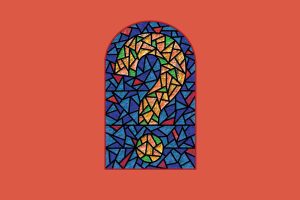Editors are the unsung heroes of culture. While some of their work amounts to fiddling with commas, they also make crucial decisions that affect the shape of the future. Am I serious? You bet. Recall the handful of folks who wrote the founding documents of our nation. Then consider the roomful of others who haggled over every last sentence, phrase, and word choice. Once those documents left the editorial room, they would be the framework of a country to come. They had to be letter perfect and to mean what they said.
If editors are vital to society, then those who serve as compilers are an elite corps among that profession. Their work takes them beyond polishing sentences and sharpening nuances. Compilers determine which texts see the light of another day, which are worthy of promoting. They influence how texts will be understood in the future—as significant or bogus, fundamental or passé. They arrange material, bringing some ideas to the front and tucking others to the rear. They put contradictory passages side by side to remind the reader that there are other points of view.
So let’s talk about the Bible. No matter how you feel about it, whether or not you consider it a sacred book, you have to admit it’s been a most influential collection of writings. Therefore it’s worth asking: Who decided what got in the Bible to begin with? How did this material get organized into the familiar package we call the Bible today?
This is a question of canon. The word is derived from the Greek word for bar or rod. A craftsman’s canon created the standard by which all things were measured. Early church fathers used the term to describe the norm of revealed truth. Several fathers alluded to a canon of beliefs to which Christians ascribed, but they didn’t apply the term to a collection of sacred writings. Collections of texts were endorsed by Origen and others, though none claimed to be definitive—until Eusebius, bishop of Caesarea, added his considerable opinion at the start of the fourth century. Eusebius was in love with lists. He offered the earliest known listing of what we call today New Testament writings. Eusebius called it simply a catalogue.
In 367 Athanasius supplied a canon of “divine” books, along with another group used by “heretics” that he termed “apocryphal.” The list of 27 canonical texts supplied by Athanasius was only slightly amended from that of Eusebius. It’s the New Testament as we know it.
That explains the origin of the Christian catalogue of sacred books. How did we come to acquire our Old Testament? That’s a longer story. Both Athanasius and Jerome agreed that 22 books from the Hebrew writings should be included in the Christian Bible. Twenty-two sounds like a petite number compared to the 46 Old Testament books in our current Catholic Bible. But the count is actually much closer. All 12 of the minor prophets inhabiting the same scroll were considered a single book, and the presently numbered double books (1-2 Samuel, 1-2 Kings, 1-2 Chronicles, Ezra-Nehemiah, and Jeremiah-Lamentations) were counted as five, not 10. The Book of Ruth was likewise attached to Judges, and so 39 of our 46 books appeared on the fourth-century lists of Athanasius and Jerome.
Who spoke up for the outlying seven texts? No less a figure than Augustine, who fought above his weight class in every ecclesial debate and generally won. Western church councils going forward endorsed 46 Old Testament and 27 New Testament texts. These official pronouncements didn’t silence the debate, but they did represent the orthodox consensus.
Some leaders still preferred to nuance the collection. In the 16th century Pope Sixtus divided the Old Testament into protocanonical and deuterocanonical works, proto meaning those works that came before and deutero meaning there that are secondary to the canon. He intended simply to distinguish between the works that all believers, including the Jewish community, accepted as canonical and those with fewer takers. The pope acknowledged that the remaining seven texts—Tobit, Judith, 1-2 Maccabees, Wisdom, Sirach, and Baruch, plus additions to Esther and Daniel—were still disputed by some. Emerging Protestant groups at the time would question the deuterocanon more seriously, and jettison it from their Bibles.
In response, the Council of Trent in 1546 declared the 73 books of the Catholic Bible to be “sacred and canonical” and inspired by the Holy Spirit in every part. Three hundred years later, the First Vatican Council would have nothing left to do but to confirm the biblical list canonized at Trent. In the 20th century, Vatican II described in soaring language how “Holy Mother Church, relying on the faith of the apostolic age” recognized the 73 biblical books as written under the Holy Spirit’s inspiration with “God as their author.” That phrase, “relying on the faith of the apostolic age” perhaps overstates the case. When it came to the canon of scripture, in those first centuries the faith of the age was up for grabs.
Scripture scholar Raymond Collins asks us to make some nuances of our own when reflecting on the significance of the centuries-long battle for canonicity. Consider, Collins suggests, that canonicity and inspiration are not interchangeable terms. A canon is a fixed list, a closed category. The historical impact of claiming 73 particular texts as canonical and sacred is indisputable. We’ve proclaimed them through the centuries in our assemblies. They’ve informed church teaching, supported church law, and are responsible in great degree for the Christianity we express. There’s no going back from the legacy we’ve inherited from these texts.
Nor would we want to necessarily. Imagine Genesis without apocalypse, or Moses without the kings. Consider an Old Testament with historical books but no prophecy, or both of these but lacking the entire Wisdom tradition. Imagine a church with gospels from Matthew, Mark, and Luke but without the magnificent cosmic perspective of John. Or four gospels without Paul’s gritty real-time exploration of what claiming Jesus personally means. No matter what we might choose to cull from the present collection, some richness, warning, comfort, challenge, or exaltation would be lost. Even passages we may dislike are valuable because of what they reveal about human nature and its pursuit of the divine.
Collins recommends we recognize that canonicity and inspiration “designate different realities.” Canonicity implies a closed collection. Inspiration acknowledges the divine movement in its composition. The two realities chase each other’s tails in that the canon, once formed, was declared inspired. And once deemed inspired, a text has no place but in the canon. It’s like that old gauntlet thrown down at the start of any defense: “The church has always taught.” How do you un-teach an ensconced truth?
Which means we’re stuck with the prophet Obadiah and the letter of Jude. Long ago important voices were raised in their favor, and now their words are in the canon. To say these texts are inspired means simply that we must attend to them. How we use them, of course, is still up to each generation.
This article also appears in the September 2018 issue of U.S. Catholic (Vol. 83, No. 9, pages 47–49).
Image: Dan Kiefer on Unsplash













Add comment